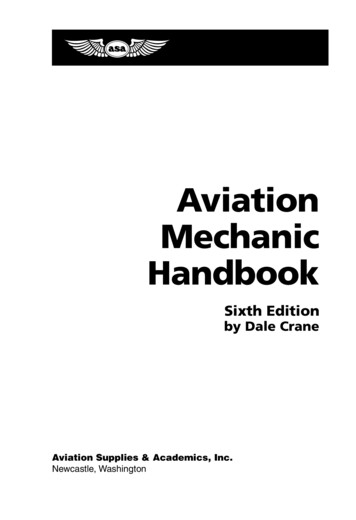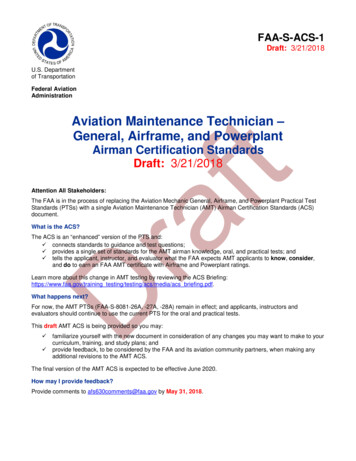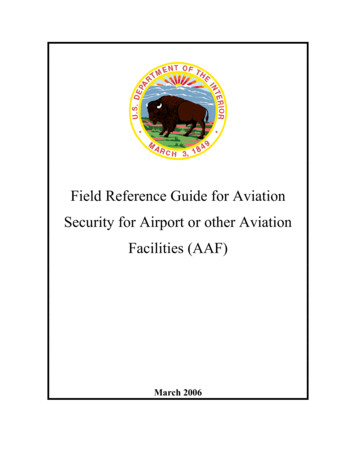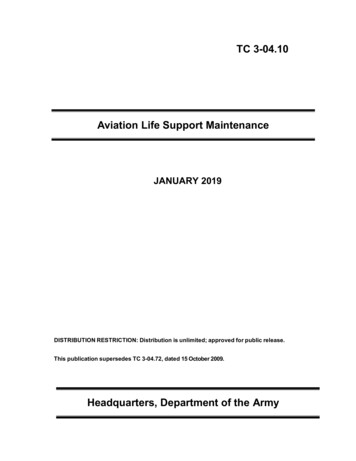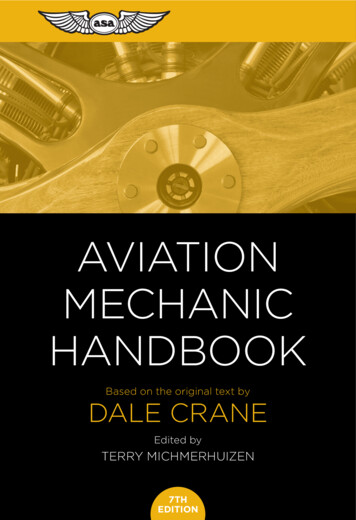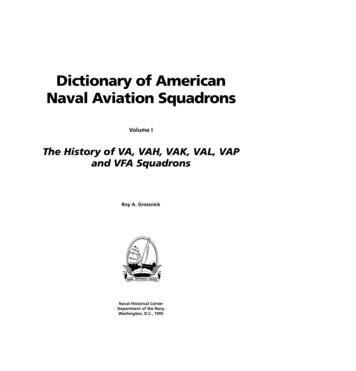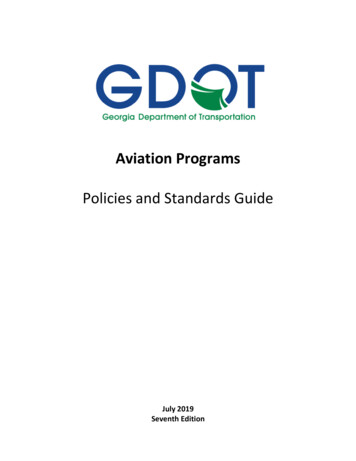
Transcription
Aviation ProgramsPolicies and Standards GuideJuly 2019Seventh Edition
Record of RevisionsRevision DateJune 2019Revision SummaryReformatted and revised Guide-various pages
TABLE OF CONTENTSINTRODUCTION . 3PART I – STATE FUNDED PROJECTS . 5CAPITAL IMPROVEMENT PROGRAM . 6AIRPORT FUNDING . 6PROJECT APPLICATION AND SELECTION . . . . 6PROJECT CONTRACTS . . . 8ELIGIBLE PROJECTS. 8APPROACH AIDS . 8DEVELOPMENT . . . 9MAINTENANCE . 10PLANNING . 10PART II – FEDERALLY FUNDED PROJECTS. 13COMMERCIAL SERVICE AIRPORTS . 14GEORGIA STATE BLOCK GRANT PROGRAM . 15PROJECT APPLICATION & SELECTION . . 15ENVIRONMENTAL REQUIREMENTS . 18AIRPORT PLANNING PROJECTS . 21LAND ACQUISITION . 23PROCUREMENT OF CONSULTANT SERVICES . 24AIRPORT DEVELOPMENT PROJECTS . 26PLANS AND SPECIFICATIONS. 27BIDDING . 29PROJECT DEVELOPMENT . 30CONSTRUCTION REQUIREMENTS . 31PART III – APPENDICESSTATE PRIORITY SYSTEM – APPENDIX ASTATE APPLICATION FORM – APPENDIX BFEDERAL PRIORITY SYSTEM – APPENDIX CFEDERAL APPLICATION FORM – APPENDIX D-2-
INTRODUCTIONThis document is intended to serve as a guide to the sponsors of “publicly-owned open-to-the-public”airports in the State of Georgia. The content of this guide identifies the policies and standards associatedwith applying for and receiving state and federal financial aid for an airport improvement project. Part Iapplies to projects funded with only state financial assistance. Part II applies to projects providing federaland when eligible, state, financial assistance. Part III contains the appendices. Questions regarding anydata contained in this document should be referred to the Georgia Department of TransportationAviation Programs, 600 West Peachtree St., NW., 6th Floor, Atlanta, Georgia 30308, or email ataviationprograms@dot.ga.govThe Georgia Department of Transportation is authorized by O.C.G.A. § 32-2-2 to plan for and establish along-term policy in regard to the establishment, development, and maintenance of airports and aviationfacilities in the state.The Georgia Department of Transportation was designated by the Federal Aviation Administration (FAA)as a State Block Grant Program (SBGP) participant in 2008 to receive and administer federal funds forpublicly owned general aviation airports beginning with federal fiscal year 2009 (October 1, 2008).NOTE: This is the SEVENTH (7th) EDITION of this publication. This document supersedes all previouseditions.-3-
PART ISTATE-FUNDED PROJECTS-4-
GEORGIA AIRPORT AID PROGRAMforSTATE-FUNDED PROJECTSThe Georgia Airport Aid Program (GAAP) is designed to provide state funding assistance for planning,capital improvements, maintenance, and approach aids to publicly-owned, public use airports.Funds are appropriated by the Georgia General Assembly annually and all airport monies must beobligated by contract during the state fiscal year, July 1 – June 30, in which the funds are appropriated.State funds cannot be rolled over and must be under contract by the close of the state fiscal year.Otherwise the state funds are returned to the Georgia general fund.For a requested project to be eligible for state funding assistance, the airport must be in compliance withthe following: The airport must be included in the Georgia Statewide Aviation Systems Plan (GASP).The airport must be publicly owned and opened to the public.All project work must be available for public use.The airport must submit a state application requesting funding assistance.The requested project must be shown on the approved Airport Layout Plan (ALP).The requested project must be included in the airport’s Five-Year Capital Improvement Program(CIP) as submitted to GDOT.The airport sponsor must own or, in some cases, lease the land upon which the project will beaccomplished.The airport must be in compliance with Georgia Airport Licensing Standards or present anacceptable statement to GDOT that licensing violations are currently being corrected. The airport’s assigned GDOT Aviation Programs Project Manager can advise the status of any of theabove items.All state-funded airport projects also require the airport sponsor be in compliance with: O.C.G.A. §36-81-7, which requires local governments forward a copy of their annual audit reportto the State Auditor for review.O.C.G.A. §36-81-8.1, which requires local government recipients of grants from the Governor’semergency fund or from a special project appropriation annually submit a grant certificationform to the State Auditor.-5-
CAPITAL IMPROVEMENT PROGRAMThe CIP is a five-year work program for each publicly-owned, public use airport in the State of Georgia.Each airport sponsor develops a list of desired airport improvement projects for each of the next fivestate fiscal years. The list should contain all proposed improvement projects that require state, federaland/or local funds. In order to enhance the value of the CIP, the airport sponsor should make every effortpossible to make the first two fiscal years of the CIP as accurate as possible. The remaining three fiscalyears should include projects based on forecasts of airport needs. The CIP is updated each year by theairport sponsor and must be submitted to GDOT Aviation Programs Office no later than November 30th.A letter requesting CIPs and the procedure for submitting to GDOT is sent to all eligible airport sponsorsno less than sixty (60) days prior to the deadline each year for submissions. Concurrently, applicationsfor state funding assistance should be submitted to GDOT Aviation Programs for state projects containedin the first year of the CIP. The application procedure for state funded projects is listed in the sectionbelow.AIRPORT FUNDINGThe Georgia General Assembly appropriates GAAP funds annually each fiscal year, July 1 through June30, based upon available state revenues and the annual budget request submitted by GDOT. The GAAPis funded from the state’s General Revenue Fund and all monies must be obligated by contract withinthe designated fiscal year. The GAAP provides state funding assistance for eligible airport projects asindicated below.Development, maintenance, approach aid, and planning projects with no federal funds involved arefunded at 75% state assistance. However, based on available state funds GDOT reserves the ability tolimit its participation for certain projects, i.e. terminal buildings, hangar site construction, etc. where theairport sponsor has the ability to secure alternate financing. All project costs incurred by the airportsponsor prior to execution of the state contract for funding assistance are NOT eligible for state financialassistance.Construction supervision, inspection, and testing on State projects may be accomplished by GDOT or theprivate sector based on the type of project and the local GDOT Area Office work load. GDOT projectinspection and testing is accomplished at 100% GDOT expense. Private sector inspection and testingcosts are paid by GDOT at 75%. All lighting, electrical, and approach aids project work must be supervisedand tested by a private firm selected by the airport sponsor.The minimum contract level of state funding assistance on all GAAP projects is 1,500.PROJECT APPLICATION AND SELECTION PROCEDUREAPPLICATION PROCEDURE – Applications for state-funded projects are accepted anytime during theyear but must be received by GDOT by November 30th for consideration in the upcoming fiscal year. TheState fiscal year runs from July 1 to June 30th. On April 1st each year, after the State Legislature hasappropriated the next fiscal year’s funds for the GAAP, all eligible applications are scored based on thepriority rating system defined in Appendix “A” of this guide. The highest scoring projects are evaluatedfor project readiness and a final list of projects is recommended to the GDOT Commissioner for approval.-6-
Airport sponsors will be notified by letter upon the approval of the project selection shortly after April1st regarding the status of their applications. If a project is not selected for funding, the applicationmust be resubmitted to the GDOT for reconsideration in the next fiscal year. If the airport sponsorcancels a selected project, the GDOT will review the remaining projects on the unfunded list thatapproximates the amount of funds available, and will select an alternate project. The airport owner willbe notified of the project selection.The airport sponsor must apply for state financial assistance for state projects by completing therequired state application form listed in the Appendices and also available on the GDOT AviationPrograms web site. The purpose of the application is to obtain the necessary project information so anevaluation can be made relative to need and priority. The “Certification” section of the application isvery important and the airport sponsor should fully understand its contents. By signing the application,the airport sponsor certifies compliance with all the conditions of the “Certification” section. Thecompleted application should be transmitted by cover letter to GDOT Aviation Programs, 600 WestPeachtree St., NW. Atlanta, Georgia 30308, or via email to the applicable project manager. If theapplicant desires record of delivery, it is suggested that the application be sent by certified or registeredmail.PROJECT PRIORITY SYSTEM:Project priority ranking for the GAAP is designed to give:First Priority to: Safety-related projects – first and foremost. Airports with less than 20 based aircraft – because they do not typically compete for federalstate apportionment or discretionary funds. Pavement maintenance or extension of the primary runway. Projects with an economic development component or support local or regionaldevelopment initiatives, as up to 10 additional priority points can be added if sufficientdocumentation is provided by the airport owner.Secondary Priority to: Airports with more than 20 based aircraft. Taxiway and taxilane projects. Apron projects. Navigational Aids.Lowest Priority to: Commercial Service Airports – Albany, Athens, Augusta, Brunswick, Columbus, Macon,Savannah, and Valdosta. GDOT does not financially participate in projects at HartsfieldJackson Atlanta International Airport.The State Airport Project Priority System is located in the Appendices.-7-
PROJECT CONTRACTSConstruction Projects – State funds for the GAAP are administered to the airport sponsor via statecontract. The contract provides funding assistance to construct the project as designed and engineeredin the GDOT approved project plans and specifications.The airport sponsor is responsible for developing and obtaining GDOT approval of the project plans andspecifications, advertising the project for bid, bid opening, selecting the lowest acceptable bidder, andcontracting with the construction firm to accomplish the work. After the state contract has been fullyexecuted, the GDOT will issue a ‘Notice to Proceed’ to the airport sponsor. Work as defined in thecontract may not begin before the notice to proceed is issued.Planning and Engineering Design – State funds for planning and engineering design are also administeredto the airport sponsor via state contract. The contract provides funding assistance to produce thenecessary planning or engineering design to accomplish the contract scope of work. Due limited statefunds, GDOT reserves the right to not participate in design services and will request the airport sponsorself-fund design. The GDOT will then participate in the construction.The airport sponsor is responsible for the development of the project scope of work, and typically this isaccomplished by contract between the airport sponsor and an airport consultant. The GDOT AviationProgram must review any project scope of work and concur with it along with the man-hours proposedby the airport sponsor’s consultant prior to any design work being consider eligible for fundingassistance. If the state provides financial assistance for a project, the consultant accomplishing the workmust be prequalified by GDOT and included on the list of approved prequalified consultants. The mostcurrent list of GDOT prequalified consultants for aviation area classes can be found athttp://www.dot.state.ga.us/doingbusiness/ prequalification/Pages/default.aspx.After the planning or engineering design contract has been fully executed, the GDOT will issue a ‘Noticeto Proceed’ to the airport sponsor. Work as defined in the contract may not begin before the notice toproceed is issued. The GDOT Aviation Programs office is responsible for the administration of thecontract. All pay requests from the airport sponsor to the state should be submitted by electronic copyto the Aviation Programs Project Manager.ELIGIBLE PROJECTSAPPROACH AIDS – Approach Aid projects are designed to provide state funding assistance to airportowners in need of airport approach aids. For the purpose of this document, an airport approach aid isdefined as any type of FAA-approved equipment that aids an aircraft in its approach path to a landingarea. These projects address airport needs for approach facilities that do not compete well for federalfunding.Approach Aid projects eligible for funding assistance: LocalizerGlide Slope (GS)Approach Lighting System (ALS)-8-
Precision Approach Path Indictor (PAPI)Automatic Weather Observation System (AWOS)Runway End Identification Lights (REILs)Installation of rotating beacon and lighted wind cone and segmented circle.Visual Glide Slope Indicator (VGSI)Remote/Ground Communication Outlet (RCO/GCO)Radio Control System for Approach Aid FacilitiesDifferential equipment for Global Positioning System (GPS) approachesPrecision & Non-Precision Runway MarkingsObstruction Surveys for New or Improved Instrument Approach Procedures – must beaccomplished in accordance with FAA Advisory Circular 150/5300-18C.The intent of approach aid projects are primarily to help general aviation airports achieve the lowestinstrument approach minimums possible for a straight-in instrument approach to the primary runway.Precision approach facilities such as a conventional Instrument Landing System are eligible for statefunding assistance but the project will be funded dependent upon the availability of state funds and onlyif the justification warrants the high cost associated with such a facility.DEVELOPMENT – Development projects, often referred to as capital improvement projects, are eligiblefor state funding assistance. An airport development project is defined, for the purpose of thisdocument, as a project which involves the construction or expansion of a runway, taxiway, aircraftparking apron, lighting system.Development projects eligible for state funding assistance include: New construction to include the extension, strengthening or widening of a runway, taxiway oraircraft parking apron.Runway grooving.Lighting of a runway, taxiway, or apron area.Marking of runway, taxiway, or apron area.Obstruction removal (one-time removal only, airport owner must maintain) including power lineremoval, relocation or burial, obstruction lighting and marking.Site preparation for terminal area development including hangar areas.New access and service roads.New auto parking lots.New fencing.Demolition of any existing facility required to construct an eligible development item.Construction supervision and materials testing for federally-funded projects and some statefunded projects requiring technical expertise beyond the scope of GDOT field personnel (airfieldlighting, electrical, navigational aids.).Utilities removal, relocation and/or replacement if required to accomplish a developmentproject.Terminal buildings.Engineering design costs if accomplished subsequent to the execution date of the contract.Reimbursement of design cost is not eligible.-9-
The following development items are not eligible for state funding assistance: Land and Easement Acquisition. Aircraft Rescue and Fire Fighting (ARFF) equipment and facilities. Taxiway which serves a private facility (exception is a public taxiway to a cluster of privatehangars). Facilities that are capable of producing revenue that can amortize the construction cost such asbut not limited to:- Hangars (all types).- Fuel Facilities.MAINTENANCE - Maintenance projects are eligible for state funding assistance and are designed tomaintain the airport’s operational and safety requirements including runway safety areas andobstruction removal. The intent is to help the airport sponsor accomplish major maintenance and safetyprojects. Routine and low-cost maintenance work is the responsibility of the airport sponsor.Maintenance projects eligible for funding assistance include: Reconstruction, resurfacing, application of seal coats, rejuvenators, and sealing of pavementjoints and cracks of runways, taxiways, aircraft parking aprons, auto parking areas and airportaccess roads.Runway and taxiway pavement markings and runway rubber removal.Construction of runway safety areas.Repair, rehabilitation, adjustment or replacement of existing drainage systems.Repair, rehabilitation or replacement of existing airport lighting systems and associatedequipment.Repair, rehabilitation or replacement of existing airport approach aids and associated equipment.Construction of runway blast pads.Replacement of existing airport fencing.Utilities removal, relocation and/or replacement if required to accomplish a maintenanceproject.The following maintenance items are not eligible for funding assistance: Maintenance or repair costs for terminal buildings.Repair or replacement of Fuel Facilities.Repair or replacement of Aircraft Rescue and Fire Fighting (ARFF) equipment and facilities.Repair or resurface/Replacement of any item which serves a private facility.Obstruction removal in a specific area that has previously received state funding assistance forobstruction removal.PLANNING - Planning projects are eligible for state funding to assist airport sponsors with futureairport development. Airport Layout Plans are the most common planning projects. GDOT requires thatall potential future development projects be identified on the approved Airport Layout Plan andconform to FAA design standards.- 10 -
Planning projects eligible for state funding assistance include: Airport Master PlanningAirport Layout Plans (ALPs)Environmental DocumentsSystems PlanningDisadvantage Business Enterprise (DBE) Plans and UpdatesNoise AnalysesObstruction EvaluationsCommercial Air Service StudiesEconomic Impact StudiesPavement Evaluation StudiesSite Selection StudiesLand Use PlanningProject Feasibility or JustificationTerminal Area StudiesGDOT Aviation Programs is responsible for reviewing and approving certain planning projects for generalaviation airports under the SBGP agreements with FAA, regardless of funding. Typical review time forALPs and Master Plans are up to 60 days, while Environmental Assessments reviews may take up to 180days. GDOT will coordinate with FAA lines of business for technical review of ALPs, regardless of fundingsources. Please contact the applicable GDOT Aviation Programs Project Manager or Aviation Planner todiscuss more specific information.In addition, the sponsor and GDOT Project Manager should review the most recent State Licensinginspection report to identify if any deficiencies need to be corrected. GDOT Aviation Programs canprioritize these deficiencies ahead of other project requests in the interest of safety. However, ifimmediate correction is not feasible, the sponsor must provide a satisfactory plan to address thedeficiencies to include listing projects on the airport’s CIP.- 11 -
PART IIFEDERALLY-FUNDED PROJECTS- 12 -
FEDERALLY-FUNDED PROJECTSGENERAL:This part of the guide provides information on the GDOT policies and procedures for all federally fundedairport projects.Federal funds for public airports are provided from the Airport and Airway Trust Fund which is supportedfrom excise tax revenue on aviation system users. The annual disbursement of federal funds asappropriated by the United States Congress for airport development is made by the FAA based on thefollowing categories: State Apportionment – Federal funds allocated each year for general aviation airports within eachstate. The funding level allocated to each state is based on area size and population of the state.Non-Primary Entitlements (NPE) – Federal funds are allocated for each eligible general aviationairport up to a maximum of 150,000 per year. To be eligible, the airport must be included in theNational Plan of Integrated Airport Systems (NPIAS) and must have submitted a five-year CIP.Discretionary Funds – Federal funds assigned each year at the discretion of the FAAAdministrator. Normally these funds are granted to commercial service and reliever generalaviation airports. Under special or unique conditions, a small portion of these funds are grantedto general aviation airports.Primary Entitlements – Federal funds allocated each year to commercial service airports thatenplane 10,000 or more passengers annually. The allocation level is tiered based on actual annualenplanements.The first section of this guide pertains to Commercial Service Airport projects where the federal fundsare provided by FAA directly to the airport owner. The second section covers the State Block GrantProgram (SBGP) where federal funds for airport improvements at general aviation airports are providedby block grant to GDOT. Block Grants are issued by the FAA to GDOT each federal fiscal year and containsfederal discretionary, state apportionment and non-primary entitlement funds.All federally-funded projects are given the highest priority for matching state funds. Normally, federalfunds are provided at 90% of project cost. GDOT’s matching share is 5% of eligible project costs with theremaining 5% being the responsibility of the airport sponsor. State funding eligibility is limited to workthat will be accomplished subsequent to the execution or Notice to Proceed date of the state contractThe federal priority codes are shown in the appendices.- 13 -
SECTION ICOMMERCIAL SERVICE AIRPORT PROJECTSThe following steps should be followed for state financial participation in federally-funded projects atcommercial service airports:APPLICATION for STATE FUNDS: A copy of the FAA pre-application form for a specific project that the airport sponsor desires statefunding assistance must be submitted to the applicable Aviation Program Project Manager. The preapplication must be submitted to GDOT prior to November 30th for funding in theupcoming state fiscal year that begins on July 1st and ends June 30th. If the project is selected for funding by the FAA, a Tentative Allocation (TA) notice is issued to theairport by the FAA. The airport sponsor must submit to GDOT by formal letter, a request for GDOTfinancial participation in the project. Attached to the letter should be a copy of the FAA TA letter.GDOT will also issue a TA letter for the state matching funds and the airport sponsor must confirmthe TA in writing.PROJECT DEVELOPMENT: GDOT Aviation Programs should be invited to the FAA and airport sponsor TA Conference wherea schedule of project development is accomplished. If the project is planning, design or environmental, an electronic copy of the work scope, manhours and associated cost of the project should be submitted to GDOT Aviation Programs. If the project is construction, the plans and specifications for the project must be reviewed andconcurrence gained by GDOT Aviation Programs prior to advertisement for bids. All engineering services (including design, planning, environmental, civil rights requirements,construction administration, testing and inspection) scope of work, man-hours and associatedcosts should be reviewed and concurred by the GDOT Aviation Programs prior to execution ofconstruction work order. After bids are received and lowest acceptable bid is determined, an electronic copy of thecertified bid tabulation in PDF and Excel format should be submitted to GDOT Aviation Programs. The cost for construction supervision, materials testing, and construction administration iseligible for state funding participation which is submitted by the airport sponsor for GDOT toreview and concurrence for inclusion in the state contract.GDOT CONTRACT: GDOT contract with the airport sponsor is developed and submitted to the airport sponsor forexecution. Upon final execution within GDOT, a formal “Notice to Proceed” (NTP) is issued to the airportsponsor. Any project work accomplished prior to NTP is not eligible for state funds but can beconsidered for federal funds.PROJECT ACCOMPLISHMENT: Inspection and testing of the project is the responsibility of the airport sponsor and is normallyaccomplished by a private engineering firm Pay requests should be submitted every thirty (30) days to GDOT for completed work.- 14 -
Upon completion of the project, GDOT Aviation Programs will participate in the project finalinspection.Upon final acceptance of the project work, a final pay request is submitted to GDOT.PROJECT CLOSE OUT: The Airport sponsor submits to GDOT a formal letter of project acceptance and certification ofcompliance with project materials specifications. A GDOT Audit of the project is accomplished. GDOT issues a Materials Certificate for the project and final Project Acceptance.SECTION IIGEORGIA STATE BLOCK GRANT PROGRAMGENERAL:Georgia’s participation in the FAA’s State Block Grant Program (SBGP) was effective October 1, 2008.The program provides federal funds each federal fiscal year directly to GDOT for airport improvementsat general aviation airports. The purpose of the block grant program is to transfer responsibility for themanagement of GA airport federal funding from the FAA to GDOT. The block grant contains federaldiscretionary, state apportionment and non-primary entitlement funds for eligible GA airports.Aviation Programs of GDOT is the state management office for the SBGP. This section of the Policies andStandards Guide is designed to take the airport sponsor from project application through closure andprovide practical guidance on successfully completing the Georgia SBGP project. However, this is verymuch a team effort between the airport sponsor, the airport’s engineering consultant, and GDOT. TheAviation Programs office will be involved throughout the process and is available to answer questionsand provide assistance when needed.The GDOT Aviation Programs web site at http://www.dot.ga.gov/IS/AirportAid provides valuable Airport AidProgram and airport data information.The FAA website is an excellent resource for information regarding federally-eligible airportimprovement projects. Current Advisory Circulars (ACs) and other publications can be found at theirwebsite, www.faa.gov.If you have questions about any information contained in or referred to in this Policies and StandardsGuide, please contact your Aviation Project Manager.I. PROJECT APPLICATIONI.A. PROJECT FORMULATIONThe airport sponsor is responsible for submitting the federal application form for projects to the GDOTAviation Programs office.- 15 -
For those airport sponsors with sufficient experience with federally funded projects, staff with projectscoping and estimating experience, and an approved airport layout plan on file, consultant services maynot be required at this stage. For those airport sponsors who do not have this experience or expertise,they may wish to contract with an airport consultant to assist with the project development anda
very important and the airport sponsor should fully understand its contents. By signing the application, the airport sponsor certifies compliance with all the conditions of the ertification _ section. The completed application should be transmitted by cover lett


